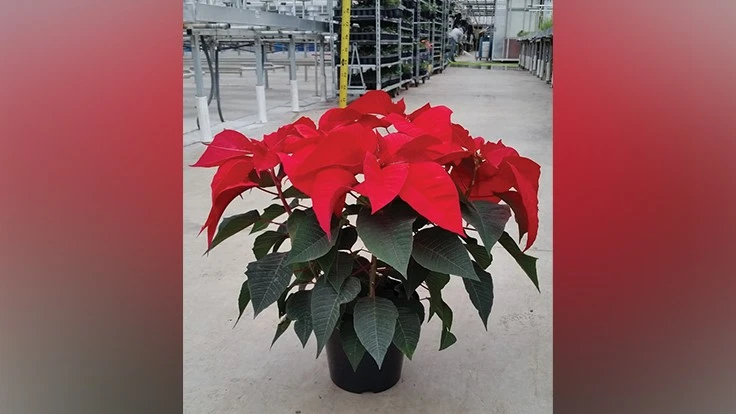

‘Tis the season! Another year of poinsettias has arrived and with it, thoughts of how to recoup more revenue on this crop that has been commoditized. One poinsettia crop that is not widely grown is the standard, single or straight-up form. These names are all synonymous for the same product — one utilizing multiple, unpinched cuttings instead of fewer or a single pinched cutting(s). While poinsettias finished from pinched cuttings are now the most common and widely grown form, poinsettias were originally grown using this multiple unpinched style.
There are several reasons why these unpinched plants are popular among both producers and consumers. First and foremost, the finished plant quality is different from pinched varieties in a few different ways. The final bract size for the unpinched plants are generally larger than those from pinched plants, and blooms also have more cyathia. If side branches are allowed to develop on unpinched cuttings, this can also result in a fuller plant, though these are removed by some producers. For these reasons, the straight-up poinsettias are often referred to as “florist quality,” for premium appearance.
In addition to plant appearance, there are also advantages aside from finished plant quality. For producers, straight-up plants have a short production time compared to the pinched forms, since the time under non-inductive long days is shorter. For example, a 6-inch container of three or four unpinched cuttings requires two to three weeks less than pinched than other varieties. The exact amount of time saved varies with container size, geographic location and cultivar vigor. However, all things equal, an unpinched poinsettia will require less bench time than the same size container finished with pinching.

For pinched poinsettias, working among the crop and handling them can result in unwanted stem breakage. When branches break off pinched plants, it not only creates a wound that can serve as an entry point for diseases and diminish plant vigor — losing branches can also render plants unsaleable. If lower branches break, plants may still be saleable, but sometimes the gaps created in canopies are too unappealing and plants are then unmarketable. With unpinched poinsettia forms, reducing breakage means less shrink and loss.
The cost for propagative material — whether unrooted or rooted cuttings — increases for unpinched poinsettias compared to the pinched form. For 6- to 6.5-inch, 7- to 7.5-inch, 8- to 8.5-inch and 10-inch containers, you will use 3-4, 4-5, 5-7, or 7-10 cuttings per container, respectively. While this does increase production costs, it doesn’t make these plants less profitable; in fact, these unpinched plants can improve your bottom line.
While the factors affecting profitability will vary with each firm, unpinched poinsettias can be a more profitable crop than pinched based on several reasons. As mentioned earlier, unpinched plants have a shorter production time, requiring less bench space. Additionally, the shorter production time will save labor, as will not having to pinch and remove leaves. When planting unpinched containers, selecting similar-sized cuttings can also simplify and reduce plant growth regulator applications, further reducing input costs. The reduced shrinkage from plants lost to stem breakage also help the bottom line. Finally, the high quality of unpinched plants with large, showy bracts can command a higher price at the wholesale and retail levels.

Explore the September 2019 Issue
Check out more from this issue and find your next story to read.
Latest from Greenhouse Management
- Happy holidays from the GIE Media Horticulture Group!
- North Carolina Nursery & Landscape Association announces new executive vice president
- Plant Development Services, Inc. unveils plant varieties debuting in 2025
- Promo kit available to celebrate first National Wave Day on May 3
- Applications now open for American Floral Endowment graduate scholarships
- Endless Summer Hydrangeas celebrates 20 years with community plantings
- Invest in silver
- Garden Center magazine announces dates for 2025 Garden Center Conference & Expo





